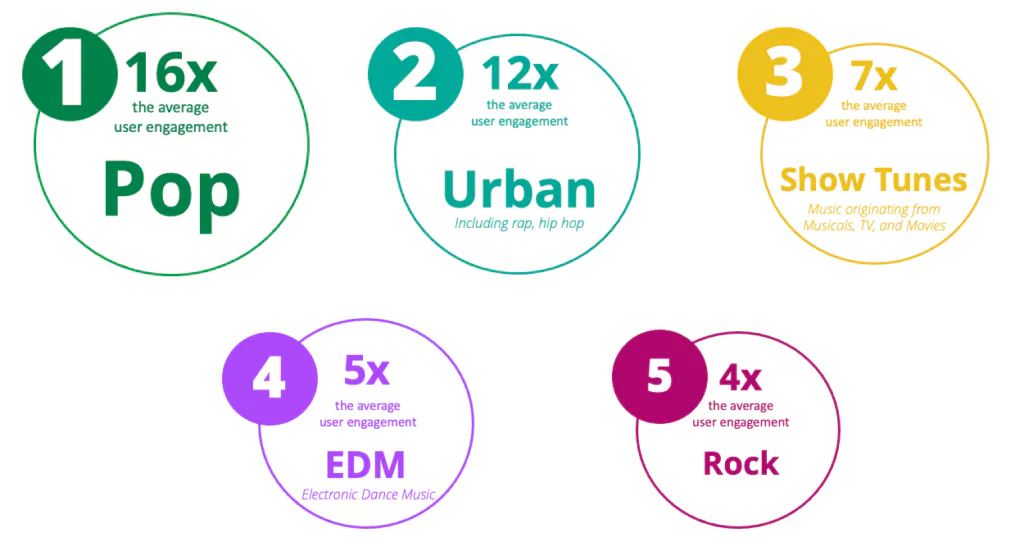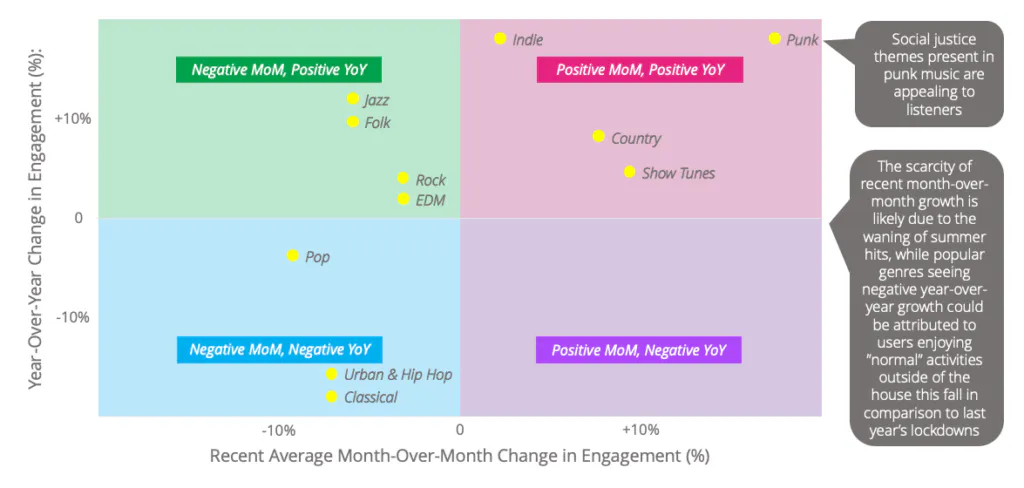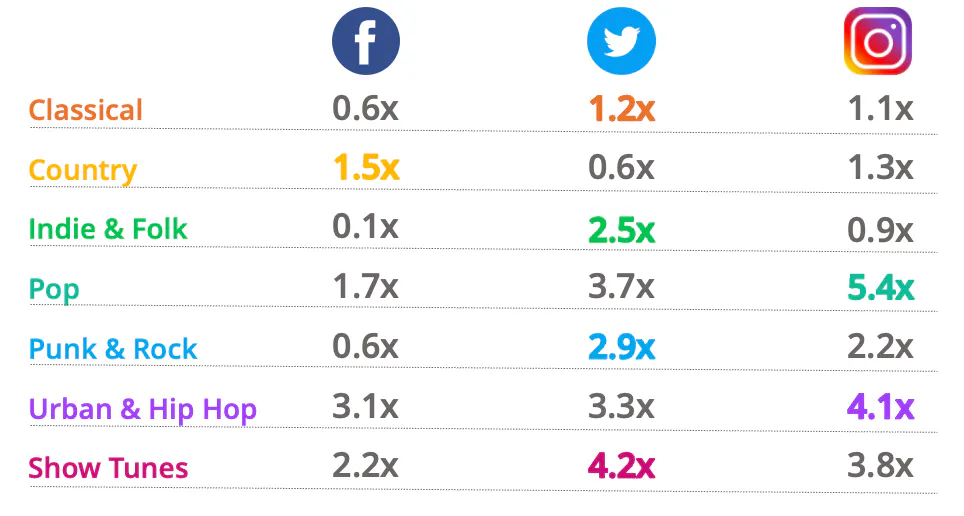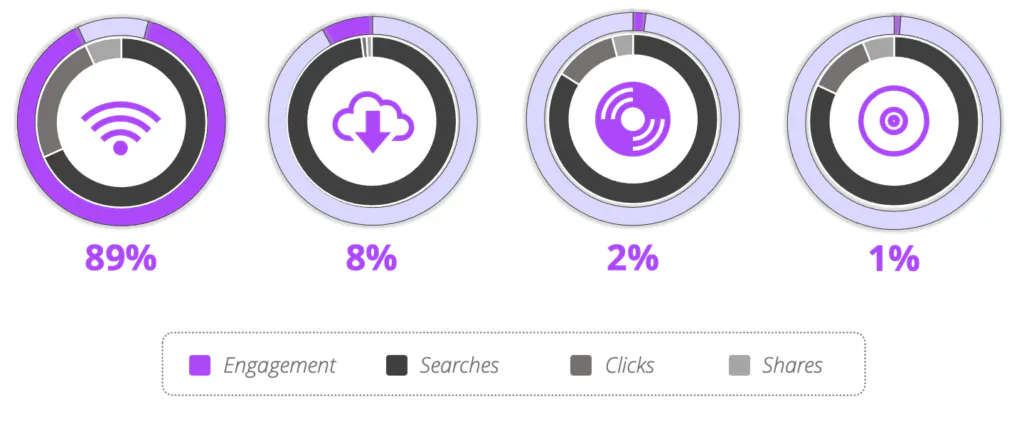Music can make a good day great, a bad day tolerable, and turn a group of people into a party. It’s like a spice: it brings flavor, a bit of pizzazz, and not everyone is going to like every flavor. Just a dash of music can motivate and inspire.
But what is popular or loved by communities changes from year to year and even month to month. While some listen to their favorite songs on repeat, others look for what’s new and exciting. For many people, music can give a sense of identity. But, of course, what we each like changes from person to person. So, what music does the world like as a whole?
Who Runs the Music World?
Who runs the music world? Pop! No surprises here, especially when today’s list of Top Billboard Artists consists of mostly pop artists, including Olivia Rodrigo, Doja Cat, The Weeknd, Justin Beiber, Taylor Swift, and Dua Lipa [source – top 200 hits week of October 16, 2021]. According to ShareThis data, the Global Music Audience engages with pop music 16x more than the average ShareThis Audience engagement. Urban music, like rap and hip hop, follows closely behind at 12x the average. Looking at the other highly ranked genres, you can see a wide variety of what the world loves to listen to—show tunes, EDM, and rock.
Online Engagement of a Global Music Audience by Volume:
But what is high today can be low tomorrow. For example, although pop currently has the highest engagement, it has dropped by almost 10% over the last few months—likely due to the end of summer hits—and has even dropped by a small margin compared to last year. This is likely due to more people going out and participating in activities rather than staying home in quarantine (which may also be feeding show tunes’ #3 rank on the top engagement list—movies, theater, and new TV are back!). Meanwhile, punk, which didn’t even make the cut for top 5 genres, has moved up the last few months—and is drastically up from last year—perhaps due to the genre’s tendency to hit hard on social justice themes.
Month-Over-Month vs. Year-Over-Year Genre Engagement by a Global Music Audience (%):
The Social Side of Things
Of course, there’s also a social element to music. Where you can share your music favorites and hear from others influences your song choice more than you think. The ShareThis data reveals that the crowd hanging out on Instagram seems more interested in pop music, likely due to its appeal to younger crowds. Meanwhile, Twitter has high indexes across every genre except country and leads in four categories—show tunes, punk & rock, indie & folk, and classical—hinting at listeners who are more particular in their preferences. As an interesting point of comparison, Facebook is so large that it’s difficult for any genre to pull too far ahead; however, it is showing a small lead in country music.
Indexes by Genre of Global Social Media Channel Audiences:
As you might expect, streaming services are the primary way most people listen to music. Among ShareThis audiences, streaming dominates at 89% engagement. Compare it to the next leader, digital download, which only got 8% of engagement. This goes to show that people value the storage on their phones more than the data they use. And even though digital download has higher engagement, both vinyl records and CDs have high numbers of clicks and shares compared to their relatively low engagement. This indicates that ShareThis audiences who look into those playback methods are actually more likely to commit compared to digital downloads.
Playback Methods’ Share of Engagement and Engagement Type by a Global Music Playback Audience (%):
Interestingly, music discovery is mainly on Soundcloud with engagement by the Music Discovery Audience at 25%. Soundcloud is known for focusing on artists rather than top hits, unlike its competitors, when giving its users suggestions. This may point to users stepping away from Spotify due to artist rights issues. With artists as varied as The Beatles, Adele, Tool, and countless independent musicians expressing criticism of the streaming giant (source), and artists’ rights coming to the forefront of the mainstream discussion for artists like Taylor Swift, Kesha, and Brittany Spears, fans may be feeling the call to choose music sources that are more supportive of the artists. People want music to be unique to them and they care deeply about the artists they listen to—and it shows here.
Percent Share of Global Music Discovery Engagement (%):

A Return to Concerts or Not?
Even when it’s not the artist or genre we prefer, music is fun and fills us with a bit of magic: magic consumers have missed. Specifically, Gen X has missed their concerts. We saw this across a variety of concert types, including pre-recorded and historical concerts (like the world tours released by groups like Queen + Adam Lambert and The Rolling Stones), artist and concert-based films (think the iconic 1997 Fleetwood Mac: The Dance or the relatively new Amazing Grace featuring Aretha Franklin), and live-streamed concerts performed in 2020 and 2021. Privately recorded concerts—specifically those from before 2020—saw a huge increase in engagement with ShareThis audiences during the pandemic, averaging an increase of 88% month-over-month. Compare this to an average increase of 42% in 2021. Of these recorded concert-goers, 41% were Gen X.
Meanwhile, live-streamed concerts saw a huge increase in 2021, specifically, among Millennials and Gen Z, increasing in average engagement by 52%. Compared to the artist-based films and the pre-recorded groups, live-streamed concerts have increased in engagement with the lifting of quarantine while the other ways of listening have decreased a bit as viewers can go back to in-person events.
Average Month-Over-Month Increase in Online Engagement vs. Concert Type by a U.S. Concert Audience (%):

2021 Age Demographic vs. Concert Type by a U.S. Concert Audience (%):

But even with many restrictions lifted and people itching to return to concerts, they still predominantly prefer safety over disappointment. For example, 43% disapproved of concerts held without any Covid restrictions; and contrast that with 48% who felt positively about concerts being canceled. Of course, the happy middle usually finds the best solution, with 77% of audiences preferring the concert be held with masks and vaccines or negative test results for entry.
Sentiment for 2021 Concerts by a U.S. Concert Audience (%):

Reading Your Audience
There’s a lot of options for music fans these days. Between genres, music services, and whether they approve of Covid-19 restrictions on concerts, people don’t always agree. From a business standpoint, identifying the trends in the data that point to what your audience prefers can feel like trying to pick out a single line of harmony in a complicated symphony—but with the right data you can make the right choice.
Contact us if you’d like to use our data to anticipate your audiences’ needs.








